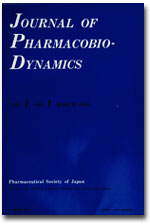Volume 4, Issue 7
Displaying 1-13 of 13 articles from this issue
- |<
- <
- 1
- >
- >|
-
1981Volume 4Issue 7 Pages 455-460
Published: 1981
Released on J-STAGE: February 19, 2008
Download PDF (588K) -
1981Volume 4Issue 7 Pages 461-468
Published: 1981
Released on J-STAGE: February 19, 2008
Download PDF (644K) -
1981Volume 4Issue 7 Pages 469-474
Published: 1981
Released on J-STAGE: February 19, 2008
Download PDF (644K) -
A SIMPLE METHOD TO DETERMINE THE RATIO OF CARDIAC TO VASCULAR β-RECEPTOR BLOCKADE IN THE RAT IN VIVO1981Volume 4Issue 7 Pages 475-482
Published: 1981
Released on J-STAGE: February 19, 2008
Download PDF (668K) -
1981Volume 4Issue 7 Pages 483-489
Published: 1981
Released on J-STAGE: February 19, 2008
Download PDF (784K) -
1981Volume 4Issue 7 Pages 490-496
Published: 1981
Released on J-STAGE: February 19, 2008
Download PDF (607K) -
1981Volume 4Issue 7 Pages 497-504
Published: 1981
Released on J-STAGE: February 19, 2008
Download PDF (836K) -
1981Volume 4Issue 7 Pages 505-512
Published: 1981
Released on J-STAGE: February 19, 2008
Download PDF (713K) -
1981Volume 4Issue 7 Pages 513-519
Published: 1981
Released on J-STAGE: February 19, 2008
Download PDF (722K) -
1981Volume 4Issue 7 Pages 520-527
Published: 1981
Released on J-STAGE: February 19, 2008
Download PDF (755K) -
1981Volume 4Issue 7 Pages 528-533
Published: 1981
Released on J-STAGE: February 19, 2008
Download PDF (637K) -
1981Volume 4Issue 7 Pages 534-540
Published: 1981
Released on J-STAGE: February 19, 2008
Download PDF (668K) -
1981Volume 4Issue 7 Pages 541-543
Published: 1981
Released on J-STAGE: February 19, 2008
Download PDF (462K)
- |<
- <
- 1
- >
- >|
